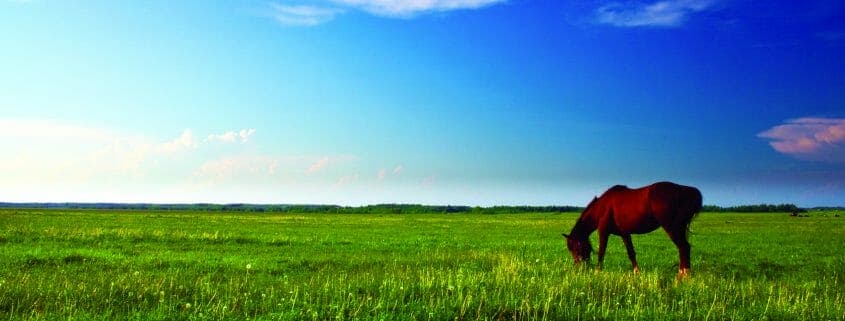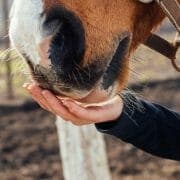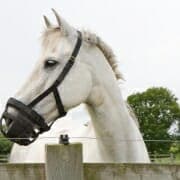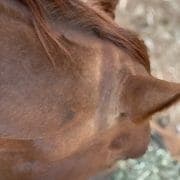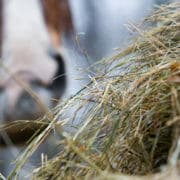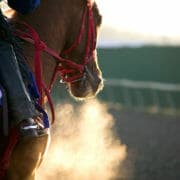Spring & Autumn Pastures
As temperatures warm up heading into spring or cool down heading into autumn you will start to notice your pastures changing as temperature and moisture conditions change. In spring you will usually see a rapid growth of lush pasture while in autumn, depending on the climate you may see a flush of growth similar to that of spring in warmer climates, or you may simply get a slower growth of lush pasture in cooler areas with possible early frosting. While this new growth is usually a welcome sight and means horses are able to return to or remain out on pasture, this new growth pasture can present some unique problems for horses.
Spring and autumn are well known as ‘danger times’ for laminitis and it is not uncommon to find more horses with diarrhoea, behavioural problems and colic during these periods. So, what is it about pastures growing during these seasons that make them unique and how can they be managed?
Weight loss, diarrhoea, and colic
Lush spring and autumn pastures can contain as little as 15% dry matter meaning they are up to 85% water. Because of the extremely high water content of these pastures, horses need to graze for long periods and eat large amount of pasture to ingest their required amount of 90% dry matter feed. For example, a 500 kg horse grazing a 15% dry matter pasture would need to eat over 60 kg of this pasture in order to consume 10 kg of 90% dry matter feed (equivalent to 2% of bodyweight). If pasture quantity is low (for example your pasture is overgrazed) this is a major challenge for any horse and can result in horses doing poorly on lush new pastures, even though on a dry matter basis they are very high in digestible energy and crude protein.
There is also very little fibre present in pastures during these early growth stages. Fibre that remains undigested to some extent as it passes the whole way through the digestive tract is important for the normal functioning of the gastrointestinal tract and the formation of manure. Horses that are not given an additional source of fibre when on lush young grass may experience diarrhoea and are at a higher risk of colic associated with a low gut fill.
Young, lush pastures can be high in nitrates. Nitrate is irritating to the gut and one of the most common symptoms of high nitrate intake is diarrhoea that may also be associated with mild to severe colic.
Dehydration and respiratory irritation
Grasses in the very early vegetative stages of growth can contain as much as 25 to 30% crude protein on a dry matter basis. While for most healthy horses this doesn’t present a problem, horses in very heavy work may find that the high crude protein level adds to their digestive heat load and will also increase urine production as the body works to rid itself of the excess nitrogen. In situations where water balance is important and water isn’t always readily available (for example in endurance horses during competition), the combination of more digestive heat and increased urination can lead to an increased risk of dehydration.
Horses that are stabled overnight or during the day and allowed to graze the remainder of the time may also experience problems associated with these high levels of protein. Excess protein causes the distinct ammonia smell often detectable when mucking out stables, which in poorly ventilated areas can cause respiratory problems for the horse.
Spookiness, aggression, and muscle problems
Rapidly growing pastures contain high levels of potassium and low levels of magnesium. While not proven in horses, excessive potassium can reduce the absorption of magnesium (possibly through its effect on the DCAD, or cation, anion difference of this diet which can then affect tissue sensitivity to parathyroid hormone) and increase magnesium excretion from the body. This effect is observed in other animal species including humans. This reduced magnesium absorption, increased magnesium excretion and an already low level of magnesium in the pasture is thought to cause chronic magnesium deficiency in horses. Young rapidly growing pastures can also contain high levels of nitrate which also increases magnesium excretion from the body. Other factors associated with some pastures including low levels of selenium and a high phytoestrogen content in clover dominant pastures can also exacerbate magnesium deficiency.
Magnesium deficiency (and the resulting active vitamin B1 deficiency) can cause normally quiet, calm horses to become ‘spooky’, behave erratically and become excited easily, show signs of incoordination, muscle tenseness, soreness or twitching and in severe cases may become dangerously aggressive and exhibit unusual herding behaviour. For more information on pasture induced magnesium deficiency, read our post ‘Is pasture affecting your horse’s behaviour?‘
Laminitis
Perhaps the condition that has received the most attention in association with spring and autumn pastures is laminitis. Green pastures use the process of photosynthesis to create non-structural carbohydrates (NSC) from sunshine, water and carbon dioxide. Under good growing conditions the plant uses these NSCs as fuel for its own growth. However, if the plant is stressed in any way or subjected to temperatures too low for growth to occur over several days, these carbohydrates will continue to be produced and will accumulate in the plants leaf and stem tissue for later use.
When horses with insulin dysregulation who are prone to laminitis graze these pastures with the high levels of accumulated NSC, laminitis can develop. Other characteristics of spring and autumn pastures may also increase the risk of laminitis for prone horses. For example, a study in cows and calves by Lentz et al (1976) found that high levels of potassium (infused as potassium chloride) caused significant elevations in plasma insulin and in the calves, this response was further exaggerated in magnesium deficient animals. So, it is possible that the high potassium content of lush pastures coupled with an induced magnesium deficiency is contributing to laminitis by causing prolonged elevations of insulin, which presumably would be worse in insulin dysregulated animals.
High levels of nitrate have also been suggested as a cause of laminitis in horses and dairy cattle, though the role of nitrates in laminitis is not clear. Pastures that are subjected to frosts or those that contain capeweed are of particular risk for nitrates, especially following application of nitrogen fertiliser.
Feeding to reduce the impact of spring and autumn pastures
There are some simple management techniques you can use to reduce the negative impact of spring and autumn pastures on your horse’s health, including:
- Provide your horses with a supplementary source of fibre in the form of hay, chaff or haylage. Give them access to free choice hay or provide them a meal of hay, chaff or haylage equivalent to at least 0.5% bodyweight (2.5 kg for a 500 kg horse) every 24 hours. This amount should be increased if pasture availability is limited. The extra fibre in these feeds will improve gut fill and manure consistency reducing the risk of colic and diarrhoea and also help your horse to consume the calories he needs when pasture water content is very high.
- If high protein intake is an issue, provide your horse with a meal of lower protein grass or meadow hay or chaff before being turned out onto pasture. You may also need to restrict your horse’s pasture intake by using a grazing muzzle, strip grazing or extending the period of time your horse is kept off pasture with access to lower protein hay.
- Have your spring or autumn pasture tested for mineral content and use this information together with FeedXL to rebalance any potassium and magnesium imbalance. Care must also be taken to provide enough salt to meet sodium requirements as a sodium deficiency reportedly increases the likelihood of a magnesium deficiency in some horses.
- Manage grazing times to reduce the risk of laminitis. If NSCs are suspected as causing issues for your horse you should restrict grazing to only the very early hours of the morning, removing the at-risk horse from pasture by 2 hours after sunrise. If nitrates are suspected (for example on post-drought pastures or capeweed infested pastures) horses should only be allowed to graze in the late afternoon and into the early evening. A grazing muzzle can be used at any time to reduce pasture intake while allowing the horse to move freely around the pasture. If a muzzle is used for limited periods of grazing, care must be taken to provide additional forage in the form of hay or haylage to ensure minimum forage requirements are met. FeedXL will help you to calculate your horse’s minimum forage requirement and how much additional forage must be fed each day in order to meet the minimum requirement.
- Don’t overgraze your pasture. Pastures that are constantly very short and in the early stages of growth are the ones that are highest in potassium and nitrates and lowest in fibre and magnesium. Use good grazing management and rotational grazing strategies to allow pastures to stay at a healthy height and stage of growth. As a general rule of thumb don’t graze your pastures until they are at least 6 inches (15 cms) in height and then allow your horses to take half of the pasture and leave the other half there to photosynthesise and provide fuel for further pasture growth.
Pasture analysis is the key
Spring and Autmn pastures are a valuable source of nutrients for your horse and managed correctly they can be fed without any issues. But to know exactly what you are dealing with and to allow you to correctly balance your horse’s diet to avoid problems you should have your pasture tested to assess energy, protein, nitrate, NSC and mineral levels (a sample should be taken in the late afternoon for the NSC analysis and in the early morning for the nitrate analysis).
Armed with a full analysis you can then use this information together with veterinary advice and a ration analysis from FeedXL that uses your pasture analysis data to come up with a ration and a feeding strategy that will lessen the risk of any problems occurring. As they say, information is power and knowing exactly what you are dealing with in your spring and autumn pastures is no exception.
If you’d like some help finding a forage analysis lab, you can click here to download our free ‘Lab List’ with laboratories in Australia, New Zealand, United States, Canada and the UK.
Do you have a question or comment? Do you need help with feeding?
We would love to welcome you to our FeedXL Horse Nutrition Facebook Group. Ask questions and have them answered by PhD and Masters qualified equine nutritionists and spend time with like-minded horse owners. It’s free!
Click here to join the FeedXL Horse Nutrition Facebook Group

